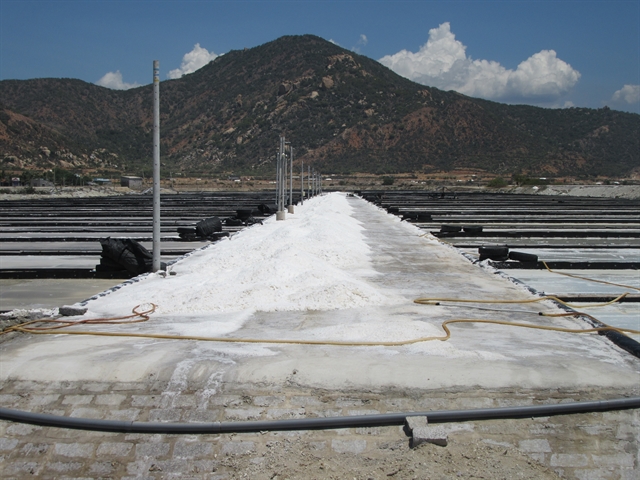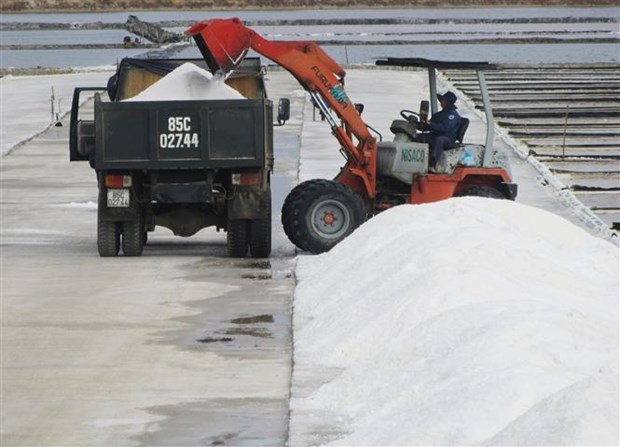 Society
Society

The south-central province of Ninh Thuận will restructure its salt production by applying advanced techniques and renovating salt fields to become the country’s leading producer by 2030, according to its Department of Agriculture and Rural Development.

|
| Fields covered with canvas sheets to keep impurities out of salt in Ninh Thuận Province. This model ensures high quality and output. — VNA/VNS Photo Nguyễn Thành |
NINH THUẬN — The south-central province of Ninh Thuận will restructure its salt production by applying advanced techniques and renovating salt fields to become the country’s leading producer by 2030, according to its Department of Agriculture and Rural Development.
The coastal province is one of the country’s largest salt producers and has a tradition of making salt for hundreds of years, mostly in Ninh Hải and Thuận Nam districts.
With a coastline of 105km, it has favourable conditions like having seawater with a high salinity content and dry and hot weather year round, which not only helps the water evaporate faster but also produce large, dry grains of salt.
But the province faces difficulties because of small-scale production and low prices.
Farmers produce salt using the traditional method of pumping seawater into salt fields, waiting for the water to evaporate under the sun for a week and then harvesting the salt.
Nguyễn Văn Được, who has been doing this for 20 years in Ninh Hải’s Tri Hải Commune, said his 6,000sq.m field produced eight tonnes of salt a week because of favourable weather conditions this year.
But prices are low, and so he has not made much profit.
Most farmers use the traditional method and operate on a small scale without contracts, and so face problems like inconsistent prices and demand. Many others have switched to other vocations, causing a decline of 188ha this year to 3,078ha of fields, according to the department.
To get higher prices, farmers need to use techniques like covering the salt fields with canvas sheets to keep out impurities.
But the sheets cost around VNĐ1 billion (US$43,240) for a hectare, and so many farmers stick to use traditional methods.
According to Trần Thanh, director of the Khánh Nhơn Salt Production and Trading Co-operative in Ninh Hải, the co-operative produces salt on 200ha but only 3ha are covered with sheets.
Đặng Kim Cương, director of the department, said to develop salt production, the province was implementing the Government’s development programme for 2021-30 and its own restructuring plan to adapt to climate change.
Under the former, Ninh Thuận will become the major industrial salt producer in the south-central region and lead the country in terms of both area and output by 2030.
Targets
The province plans to produce salt on 3,267ha this decade and have an annual output of 650,000 by 2030, including 550,000 tonnes produced industrially.
To achieve the targets, it will upgrade existing infrastructure for industrial production and develop production models using advanced techniques, according to the department.
It will study renovation of fields in such a way that machines can be used in all stages from pumping seawater to harvesting the salt.
The department is working with relevant agencies and localities in the province to draft plans to produce, process and consume salt.
It seeks to develop companies that can produce on a large scale using advanced techniques and process other salt-related products to add value.
The province will assist individuals and organisations with building warehouses and stockpiling salt to stabilise prices.
It will help small and medium-sized establishments set up salt processing facilities.
It will expand clean production models and establish salt co-operatives and co-operative groups.
It will work with ministries and other agencies to forecast demand for salt and draw up proper production plans based on that.
It will work to build brand names and carry out promotions for salt-related products. — VNS

|
| Industrial salt production in Ninh Thuận Province’s Ninh Hải District. — VNA/VNS Photo Nguyễn Thành |